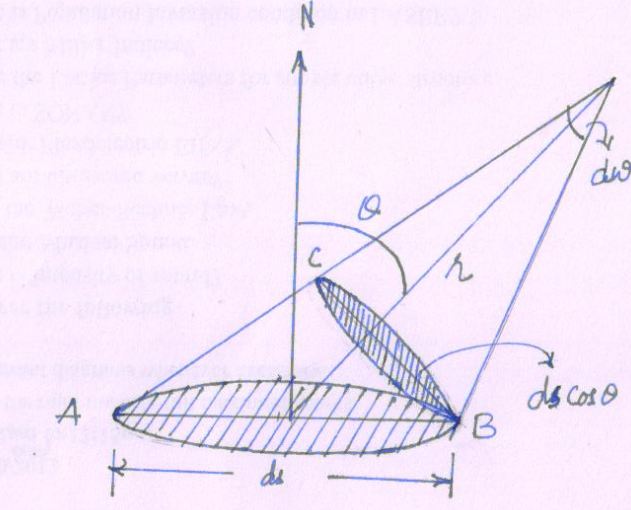Site pages
Current course
Participants
General
MODULE 1. Magnetism
MODULE 2. Particle Physics
MODULE 3. Modern Physics
MODULE 4. Semicoductor Physics
MODULE 5. Superconductivty
MODULE 6. Optics
LESSON 32. Law of Photometry
Law of Illumination
Inverse Square Law
“The intensity of illumination of surface (E) or illumination of surface (E) is inversely proportional to the square of the distance between the surface and source”.
Hence, intensity of illumination of surface
\[\left( E \right)\] \[ \propto\] \[{1 \over {distbetweenthesourceandsurface}}\]
\[\left( E \right)\] \[ \propto\] \[{1 \over {{r^2}}}\]
Physical significance of inverse square law
According to the following figure suppose the source(s) is at center (o). It emits the light in all directions.
Now, the Q amount of the light is emitted in unit time and it incident on the two surfaces A and B. Surface A is at distance r1 and surface B is at distance r2 from source respectively.
The intensity of illumination of surface E = \[{{Theamountoflightwhichflowfromilluminatingsurfacepersec} \over {Areaofilluminatiom}}\]
For surface A, E1 = \[{Q \over A}\] = \[{Q \over {4\pi r_1^2}}\]
A Surface area of the circle
For surface B, E2 = \[{Q \over {4\pi r_2^2}}\] ……… (1)
But illumination power (I) = \[{{LuminousFlux} \over {SolodAngle}}\]
I = \[{Q \over {4\pi }}\] …… (2)
From equation (1) and (2)
Lambert’s Cosine Law
“The illumination is directly proportional to the “Cosine of the angle made by the normal to the illuminating surface with the direction of the incident flux”.
Note: Cosine angle either angle between the normal and the direction of the incident flux or the angle between two plane surfaces (one is normal incident surface and other is bend surface)
Lambert derived a relation between normal illumination En and slanting illumination E for the same distance.
Let S is point source at distance r from surface area ds (original)
I is luminous intensity or illumination power of the point source(S)
dω is solid angle; subtended by ds and slanting area are same at point source(S)
θ is the angle between normal to the surface area ds and the direction of incident flux.

Fig 21(2)
According to resolved figure,

Fig 21(3)
\[ds\cos \theta\] = \[x\] = BD
Luminous Intensity (I) = \[{F \over w}\]
But dF are fluxes in solid angle dω
I = \[{dF \over dw}\]
Solid angle dω = \[{{ds\cos \theta } \over {{r^2}}}\]
dF = I dω
dF = \[{{Ids\cos \theta } \over {{r^2}}}\]
I = \[{{{r^2}dF} \over {ds\cos \theta }}\]
Expression reports
Light illumination with intensity I and making solid angle \[{{ds\cos \theta } \over {{r^2}}}\] w.r.t area ds cos \[\theta\] . Due to that solid angle, luminous flux dF is slanting with angle \[\theta\] and focusing to surface ds (original).
Light illuminates with intensity I from source. Source is slanting mode w.r.t. normal. It is going to illuminates original surface ds. So, intensity fluxes dF illuminating the surface with slanting angle cos \[\theta\] and with dF flux is illuminating surface ds.
Illumination or Intensity of illumination of surface E = \[{F \over A}\]
Hence E = \[{dF \over dS}\]
E = \[{{Ids{\rm{Cos\theta }}} \over {ds{r^2}}}\]
E = \[{{I{\rm{Cos\theta }}} \over {r^2}}\] …… (2)
For Normal (direct) illumination
En = \[{I \over {{r^2}}}\]
E = En Cos \[\theta\]…… (3)
Equations (2) and (3) are the two form of Lambert’s Law